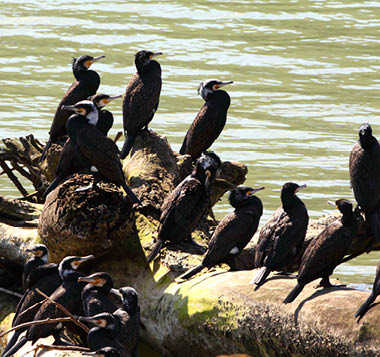For many decades we witness that the ever-growing cormorant colonies across Europe cause great harm to fish stocks, including harm to threatened species like grayling and salmon.
Together with EAA, EFTTA's key messages towards the EU Parliament, the EU Commission and the EU Member States are the following:
The Birds Directive is not only about bird protection but also about control and management;
Fish stocks also need protection;
Member States must properly implement the Birds Directive and make appropriate use of the derogations to protect flora, fauna and fisheries against damage made by cormorants; and
Development and set-up of cormorant management plans, including minima on a regional level, beginning with the Nordic/Baltic region.
The European Parliament adopted a resolution in 2008, which urged the EU Commission“to promote the sustainable management of cormorant populations by means of increased scientific and administrative coordination, cooperation and communication, and to create appropriate conditions for the drafting of a Europe-wide cormorant population management plan.”
Unfortunately, the request was not followed by the Commission. Consequently, the problem is still as serious now... In 2008 the European population of cormorants was estimated ca. 2 million. Today, the population is about the same size. The bird’s impact on threatened or protected fish species is a serious problem in many places. The quality of fishing is severely hampered in many inland and coastal locations, too. As the cormorant is highly migratory, cross-border cooperation, ideally a pan-European management plan, is required.
In France the number of cormorants is on the increase. Nevertheless, protection of open waters has been abandoned this year (2022), which triggered the French national angling organization ‘FNPF’ to ask president Macron for help. The additional number of French cormorants will add to the number of cormorants in other countries as cormorants are highly migratory birds.
Although the EU Commission recognises the need for coordinated action to address the issue of cormorants, they consider that an EU‑wide management plan would not be an appropriate measure - mainly because there is no consensus between Member States on the type of action to take. Article 9 of the Birds Directive lays down a derogation system that provides a tool to protect fisheries' interests and, if used in a more coordinated manner, can contribute efficiently to reducing the impact of cormorants on fisheries and some aquatic ecosystems.” . At present, however, the necessity and value of managing cormorant populations on a European scale is still lacking.
In May 2022, the European Parliament's Committee on Fisheries organised a public hearing on "The problem of cormorants affecting EU fisheries and aquaculture", with two experts suggested by EFTTA and EAA.
Later the European Parliament adopted “resolution of 4 October 2022 on striving for a sustainable and competitive EU aquaculture: the way forward“, which again “calls on the Commission to prepare a proposal for an EU great cormorant management plan“.
Since the cormorant problem is not resolved or lessened in spite of the European Parliament’s request more than a decade ago, EFTTA and EAA urge strongly:
All EU Member States, which don’t make efficient enough use of the derogation possibilities in the Birds Directive’s Article 9 to protect flora, fauna and fisheries against damage by cormorants to do so.
The introduction of regional management plans. A Nordic-Baltic area management, plan or cooperation scheme could be a first.
The Nordic-Baltic area hosts more than 50% of Europe’s population of nesting cormorants. The cormorants from this area cause problems not only in the Nordic-Baltic area but in many European countries during migration and winter.
Denmark, Sweden and Finland regularly conduct counts of ‘their’ cormorants and have good knowledge of the birds’ migration patterns. This is basic data and knowledge needed for a science based cross-border management scheme. All states around the Baltic Sea manage cormorants in various ways and to varying degree, but not in coordination with other countries.
Not all Baltic states need to be involved from the outset. And the scheme could be open for other states, which might show an interest in attending e.g. Norway and UK.
